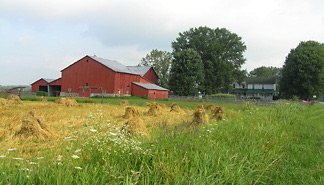From flytraps to spider-web pictures, Cooperative Extension teaches farmers alternatives in pest control
By Mary Woodsen

Cornell Cooperative Extension's (CCE) emphasis on outreach to a wide range of farmers is now bringing science-based expertise to one of New York's most traditional farm communities: Amish farm families in Cattaraugus and Chautauqua counties.
Dean Sprague, a CCE field crops educator, leads a project that teaches integrated pest management (IPM) problem-solving tactics to a group of Amish farmers near Conewango Valley, N.Y. IPM seeks least-toxic methods of dealing with pests. Meetings are held in the farmers' barns and fields.
The team-teaching project -- called Tactical Agriculture, or TAG -- has taught IPM methods to more than 900 growers who collectively farm 170,000 acres since the program began in 1990. The Amish TAG program addresses the needs of livestock and field crops operations, as well as vegetable production for Amish farmers who are branching out. About 125 Amish families live in Cattaraugus and Chautauqua counties.
Several days before a recent meeting, Sprague stopped by an Amish farm to tack several plain white index cards to overhead barn beams in the barn and milking parlor. The day of the meeting, Julie Stavisky, a livestock educator with Cornell's New York State IPM Program, checked the cards as the group gathered. They looked nearly as clean and white as the day Sprague put them up.
"There's no fly problem here," said Stavisky, noting that barn flies and other bothersome pests can reduce milk yields by as much as 15 percent. "You're doing a great job of keeping organic matter cleaned up. Now, if you saw about 100 spots on each card, you'd want to make serious plans for fly management."
Because many flies have become resistant to sprays, Stavisky recommends improved sanitation to reduce fly-breeding habitats. "Nothing could be more important," Stavisky said. "This also helps keep the good guys going -- the beneficial organisms that play a major role in fly control."
The second line of defense: baits, carefully used, and sticky flytraps, ribbons and tapes. There is even a super-sized version, about 6 feet long and a foot wide. "Some ribbons emit a fly-attracting scent and have pictures of resting flies or spider webs on them," Stavisky said.
Why spider webs? "Perhaps the theory is that flies like to have something to land on," Stavisky says. "Maybe spiders have been on to something all along."
The hands-on training approach works. "At our most recent meeting, one farmer told me that he'd drastically cut his fly problem based on what he learned," Sprague relates.
To learn more about IPM, see http://www.nysipm.cornell.edu.
Mary Woodsen is a science writer with Cornell Cooperative Extension's Integrated Pest Management program.
Media Contact
Get Cornell news delivered right to your inbox.
Subscribe